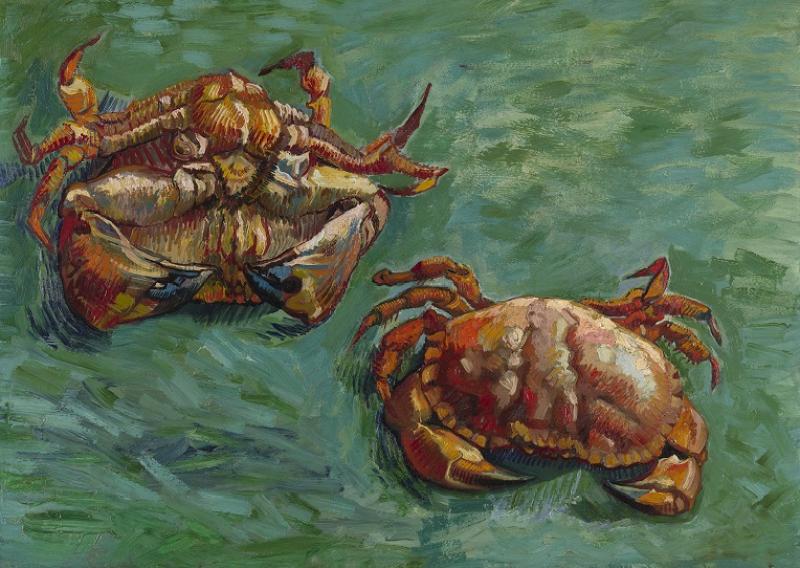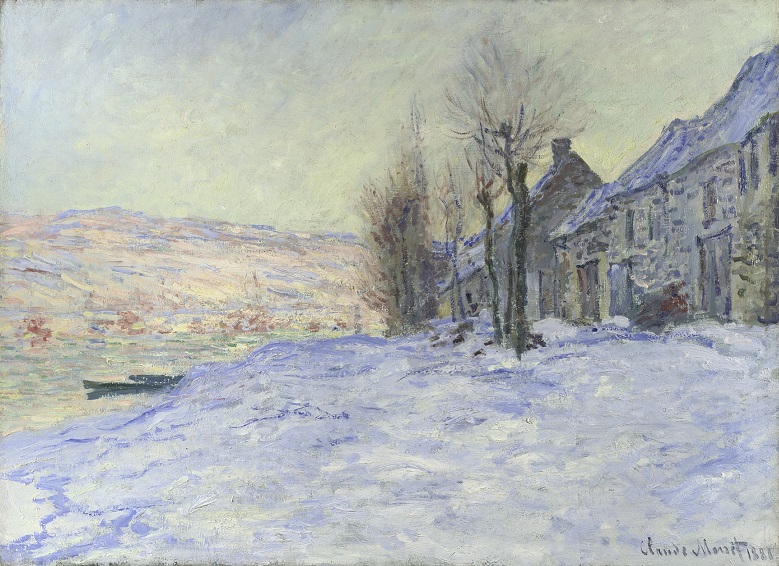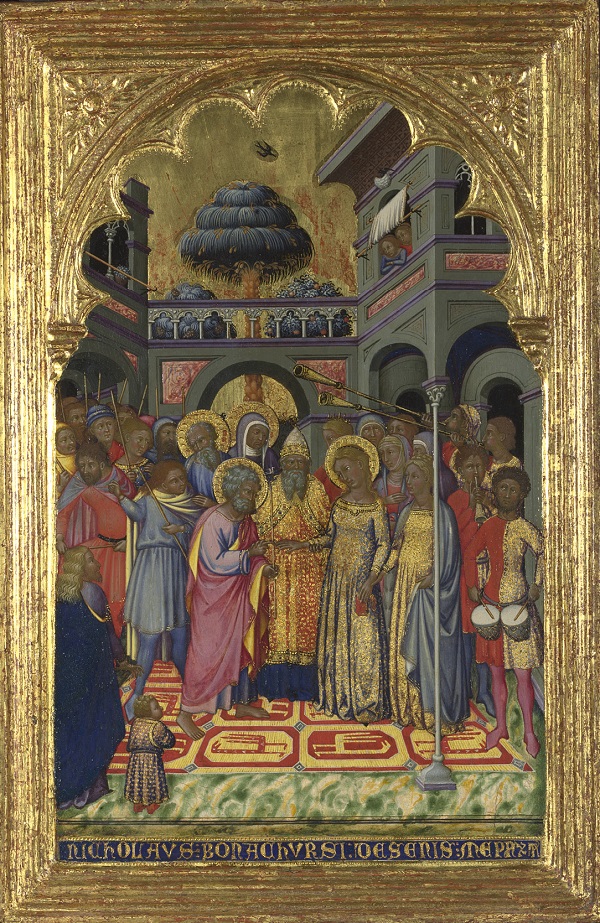Making Colour, National Gallery | reviews, news & interviews
Making Colour, National Gallery
Making Colour, National Gallery
An exploration of colour brings art and science together, but it's an uneasy relationship

The National Gallery has a range of personas it adopts for its exhibitions, and for this one, about colour, it has deployed the po-faced, teachy one. The pompous tone is because it’s not just about art this time, there’s science in it, which makes it extra serious.
This is a subject I find very, very interesting, and I think it is fair to say that many of the curiosities that arise from looking at early Renaissance paintings, in particular, are to do with colour. The cheerfully exotic blue trees in Niccolò di Buonaccorso’s The Marriage of the Virgin (pictured below left), about 1380, are entirely the result of an unwise choice of pigment. Mixed from a durable blue pigment and a much less light-stable yellow pigment, what must once have been a good strong green has lost all traces of yellow, leaving only a slightly comical, vivid blue.
 Light sensitive pigments, red ones this time, are the cause of the unhealthy green flesh tones so characteristic of many Renaissance panel paintings. In David Ghirlandaio’s The Virgin and Child with Saint John, probably about 1490-1500, the pink flesh tones have faded so that we can see through to the layer of green earth beneath; put there to balance skin tones and make them more naturalistic, the green was never meant to be visible. And in more modern times, the wonderful icy blue that runs through Monet’s Lavacourt Under Snow (pictured above right), about 1878-81, can be seen as a celebration of cobalt blue, just one of the synthetic blues that revolutionised painting in the 19th century by making available a range of affordable, reliable colours.
Light sensitive pigments, red ones this time, are the cause of the unhealthy green flesh tones so characteristic of many Renaissance panel paintings. In David Ghirlandaio’s The Virgin and Child with Saint John, probably about 1490-1500, the pink flesh tones have faded so that we can see through to the layer of green earth beneath; put there to balance skin tones and make them more naturalistic, the green was never meant to be visible. And in more modern times, the wonderful icy blue that runs through Monet’s Lavacourt Under Snow (pictured above right), about 1878-81, can be seen as a celebration of cobalt blue, just one of the synthetic blues that revolutionised painting in the 19th century by making available a range of affordable, reliable colours.
I suspect that the exhibition has been organised colour by colour, rather than by date, or geography, because to do so looks technical and dispassionate, in keeping with the exhibition’s decidedly scientific bent. But the approach is riddled with problems, the greatest being that all colours are not equal. Some, like blue and green, really can yield insights into why and how paintings look as they do, but once you get onto yellow and purple, there is only a limited amount to be said.
And so it is that Gainsborough’s The Painter’s Daughters Chasing a Butterfly, about 1756, is put in a room with some other very yellow paintings in order to point out that one of the dresses is painted with lead tin yellow. Queasy headache aside, it is a curatorial strategy that leaves you unable to make any sense of what is on the walls unless you read all the labels, a sure sign that things have gone belly-up.
 If you were hoping to be blinded with science, only disappointment awaits. Aside from some photographs showing cross sections of paint layers and occasional little pots of pigment, the science is often elusive and always unsatisfactory. Where it exists, it is descriptive rather than explanatory, and betrays the uneasy relationship between science and art and an uncertainty about how to communicate scientific ideas to the public. A section on colour theory presents an array of paintings that exploit the effects of juxtaposing certain colours, with Van Gogh’s Two Crabs, 1889, (main picture) and Carlo Crivelli’s Saints Peter and Paul, probably 1470s, a fine sight in a room devoted to the stunning results achieved by using combinations of complementary and primary colours.
If you were hoping to be blinded with science, only disappointment awaits. Aside from some photographs showing cross sections of paint layers and occasional little pots of pigment, the science is often elusive and always unsatisfactory. Where it exists, it is descriptive rather than explanatory, and betrays the uneasy relationship between science and art and an uncertainty about how to communicate scientific ideas to the public. A section on colour theory presents an array of paintings that exploit the effects of juxtaposing certain colours, with Van Gogh’s Two Crabs, 1889, (main picture) and Carlo Crivelli’s Saints Peter and Paul, probably 1470s, a fine sight in a room devoted to the stunning results achieved by using combinations of complementary and primary colours.
But should the National Gallery, custodian of one of the world’s great art collections, be quite so surprised that artists knew about these special colour relationships long before scientists formalised them? The curators seem unaccountably amazed that Crivelli’s "sense of colour is intuitive", while Annibale Carracci, who made deliberate use of primary colours despite almost certainly not having read up on colour theory, is treated with the same slack-jawed awe.
It is a worrying disclosure, because it suggests that at the National Gallery, in common with wider society, there is a tendency to elevate science over art, indiscriminately treating science, whether good or bad, with credulous acceptance. Just as cosmetics manufacturers know that a lab coat can shift face cream, this exhibition, which claims to "bring together the worlds of art and science" tries to add value by claiming a scientific basis, while simultaneously backing away from taxing its audience with any genuine insights. The tendency to crave validation by science is an insidious one, that undermines the value that good science can offer while pointing to a fundamental lack of confidence in art itself from the very institution that should be its champion.
Explore topics
Share this article
The future of Arts Journalism
You can stop theartsdesk.com closing!
We urgently need financing to survive. Our fundraising drive has thus far raised £33,000 but we need to reach £100,000 or we will be forced to close. Please contribute here: https://gofund.me/c3f6033d
And if you can forward this information to anyone who might assist, we’d be grateful.

Subscribe to theartsdesk.com
Thank you for continuing to read our work on theartsdesk.com. For unlimited access to every article in its entirety, including our archive of more than 15,000 pieces, we're asking for £5 per month or £40 per year. We feel it's a very good deal, and hope you do too.
To take a subscription now simply click here.
And if you're looking for that extra gift for a friend or family member, why not treat them to a theartsdesk.com gift subscription?
more Visual arts
 Help to give theartsdesk a future!
Support our GoFundMe appeal
Help to give theartsdesk a future!
Support our GoFundMe appeal
 Ed Atkins, Tate Britain review - hiding behind computer generated doppelgängers
Emotions too raw to explore
Ed Atkins, Tate Britain review - hiding behind computer generated doppelgängers
Emotions too raw to explore
 Echoes: Stone Circles, Community and Heritage, Stonehenge Visitor Centre review - young photographers explore ancient resonances
The ancient monument opens its first exhibition of new photography
Echoes: Stone Circles, Community and Heritage, Stonehenge Visitor Centre review - young photographers explore ancient resonances
The ancient monument opens its first exhibition of new photography
 Hylozoic/Desires: Salt Cosmologies, Somerset House and The Hedge of Halomancy, Tate Britain review - the power of white powder
A strong message diluted by space and time
Hylozoic/Desires: Salt Cosmologies, Somerset House and The Hedge of Halomancy, Tate Britain review - the power of white powder
A strong message diluted by space and time
 Mickalene Thomas, All About Love, Hayward Gallery review - all that glitters
The shock of the glue: rhinestones to the ready
Mickalene Thomas, All About Love, Hayward Gallery review - all that glitters
The shock of the glue: rhinestones to the ready
 Interview: Polar photographer Sebastian Copeland talks about the dramatic changes in the Arctic
An ominous shift has come with dark patches appearing on the Greenland ice sheet
Interview: Polar photographer Sebastian Copeland talks about the dramatic changes in the Arctic
An ominous shift has come with dark patches appearing on the Greenland ice sheet
 Donald Rodney: Visceral Canker, Whitechapel Gallery review - absence made powerfully present
Illness as a drive to creativity
Donald Rodney: Visceral Canker, Whitechapel Gallery review - absence made powerfully present
Illness as a drive to creativity
 Noah Davis, Barbican review - the ordinary made strangely compelling
A voice from the margins
Noah Davis, Barbican review - the ordinary made strangely compelling
A voice from the margins
 Best of 2024: Visual Arts
A great year for women artists
Best of 2024: Visual Arts
A great year for women artists
 Electric Dreams: Art and Technology Before the Internet, Tate Modern review - an exhaustive and exhausting show
Flashing lights, beeps and buzzes are diverting, but quickly pall
Electric Dreams: Art and Technology Before the Internet, Tate Modern review - an exhaustive and exhausting show
Flashing lights, beeps and buzzes are diverting, but quickly pall
 ARK: United States V by Laurie Anderson, Aviva Studios, Manchester review - a vessel for the thoughts and imaginings of a lifetime
Despite anticipating disaster, this mesmerising voyage is full of hope
ARK: United States V by Laurie Anderson, Aviva Studios, Manchester review - a vessel for the thoughts and imaginings of a lifetime
Despite anticipating disaster, this mesmerising voyage is full of hope

Add comment